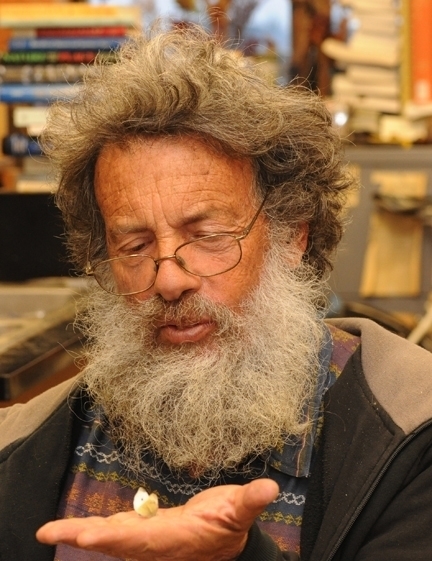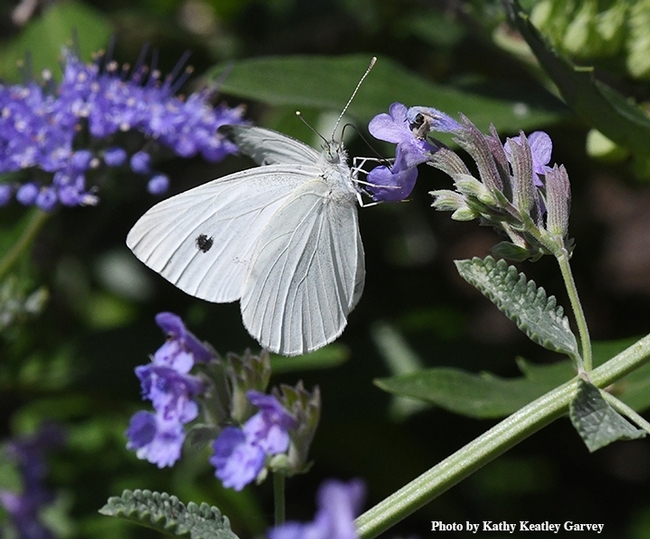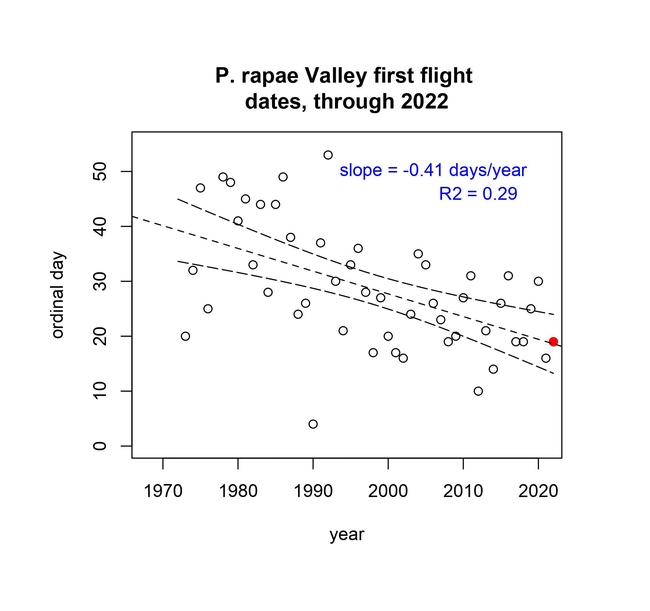
But he'll have a beer anyway!
UC Davis distinguished professor Art Shapiro, Department of Evolution and Ecology, didn't sponsor his annual public "Beer for a Butterfly" contest this year but he recorded his first-of-the-year sighting of a cabbage white butterfly, Pieris rapae, at 1:25 p.m. on Wednesday, Jan. 19 in West Sacramento near a railroad embankment.
"Pop Goes the Pieris!" Shapiro emailed to his colleagues.
And it was exactly the day that his colleague-collaborator Matt Forister, the Trevor McMinn Endowed Professor in Biology, Foundation Professor, at the University of Nevada, calculated it would be sighted.
Forister, who received his doctorate in ecology in 2004 at UC Davis, studying with Shapiro, crafts "The First Flight Date" graphics, using Shapiro's statistics. "And.... as if we had coordinated efforts (which we didn't), here's the graph!" Forister wrote in an email. "Art, you nailed it right on the regression line this time, you deserve an extra beer."
Shapiro, who maintains a research website at http://butterfly.ucdavis.
For scientific purposes, Shapiro seeks the first cabbage-white-butterfly-of-the year in the three-county area of Yolo, Sacramento and Solano. The contest is also known as "Suds for Bugs." The traditional rules: Catch a live cabbage white butterfly in the wild in one of those three counties, deliver it live to his department in Storer Hall, UC Davis (with the full data, exact time, date and location of the capture) and if it's the first of the year, the winner receives a pitcher of beer or its equivalent.
Due to COVID-19 pandemic precautions, however, Shapiro hasn't sponsored the contest for two years. But he's recorded the first ones he's seen.
In his Jan. 19th email documenting the sighting, Shapiro wrote:
"Today was a gorgeous day in West Sacramento--no high or middle clouds for the first time in seemingly forever. The site has the heaviest midwinter Crucifer bloom in many years. In order of abundance: Brassica kaber (wild mustard), Raphanus (wild radish), and B. campestris (field mustard). Also in bloom: Amsinckia (fiddlenecks) and a few Erodium (filaree) and (Lamium amplexicaule) giraffe heads. It looks like late February or even March. The twigs on almond are coloring up. No other tree action noted yet! 61F, N wind 5-10 mph but blocked by the RR embankment. It felt quite warm on the sheltered lee side, but in the open, exposed to the wind, it didn't.
"At 1:25 p.m., I encountered a male rapae dorsal-basking; it took flight at once. Since there is no contest again this year I had no net and there is no specimen. But there we are..." (He also saw a Vanessa atalanta or red admiral butterfly, "so 2 species, 2 bugs," he wrote.)
P. rapae inhabits vacant lots, fields and gardens where its host plants, weedy mustards, grow. The male is white. The female is often slightly buffy; the "underside of the hindwing and apex of the forewing may be distinctly yellow and normally have a gray cast,” Shapiro says. “The black dots and apical spot on the upperside tend to be faint or even to disappear really early in the season.”
Shapiro usually wins his own contest as he knows where to find them. Over the last five years, the contest statistics include:
- 2022, Jan. 19: Art Shapiro collected his first of the year at 1:25 p.m. in West Sacramento (no contest held due to COVID precautions)
- 2021, Jan. 16: Shapiro collected his first of the year at 1:55 p.m. Jan. 16 on the UC Davis campus, Yolo County (no contest held, due to COVID precautions)
- 2020, Jan. 30: Shapiro recorded his first of the year at 11:16 a.m. on Jan. 30 in Winters (he didn't net the butterfly so he said "no winner")
- 2019, Jan. 25: Shapiro collected the winner at 1:12 p.m., Jan. 25 near the Suisun Yacht Club, Solano County.
- 2018, Jan. 19: Shapiro collected the winner at 11:23 a.m. Friday, Jan. 19 West Sacramento, Yolo County
Since 2010, most of the winning butterflies were collected in West Sacramento:
- 2017: Jan. 19: Shapiro collected the winner on the UC Davis campus
- 2016: Jan. 16: Jacob Montgomery, UC Davis graduate student, collected the winner in west Davis
- 2015: Jan. 26: Shapiro collected the winner in West Sacramento
- 2014: Jan. 14: Shapiro collected the winner in West Sacramento
- 2013: Jan. 21: Shapiro collected the winner in West Sacramento
- 2012: Jan. 8: Shapiro collected the winner in West Sacramento
- 2011: Jan. 31: Shapiro collected the winner in Suisun
- 2010: Jan. 27: Shapiro collected the winner in West Sacramento
The butterfly is emerging earlier and earlier as the regional climate has warmed, says Shapiro, whose researches involves biological responses to climate change. "The cabbage white is now emerging a week or so earlier on average than it did 30 years ago here."
Shapiro has monitored butterfly population trends on transects across central California since 1972 and records the information on his research website at http://butterfly.ucdavis.edu/. His 10 sites stretch from the Sacramento River Delta through the Sacramento Valley and Sierra Nevada mountains to the high desert of the Western Great Basin. The largest and oldest database in North America, it was recently cited by British conservation biologist Chris Thomas in a worldwide study of insect biomass.
In its larval form, the cabbage white butterfly, known as "the imported cabbageworm," is a pest of cole crops. "Cabbageworm larvae chew large, irregular holes in leaves, bore into heads, and drop greenish brown fecal pellets that may contaminate the marketed product," according to the UC Statewide Integrated Pest Management Program. "Seedlings may be damaged, but most losses are due to damage to marketed parts of the plant."
Attached Images:

A cabbage white butterfly nectaring on lavender in Vacaville, Calif. (Photo by Kathy Keatley Garvey)

This is the graph created by Matt Forister, the McMinn Professor of Biology at the University of Nevada. Forister calculated that the first cabbage white butterfly of 2022 would be sighted in the three-county area of Yolo, Solano and Sacramento on Jan. 19. UC Davis Professor Art Shapiro sighted his first of the year on Jan. 19.